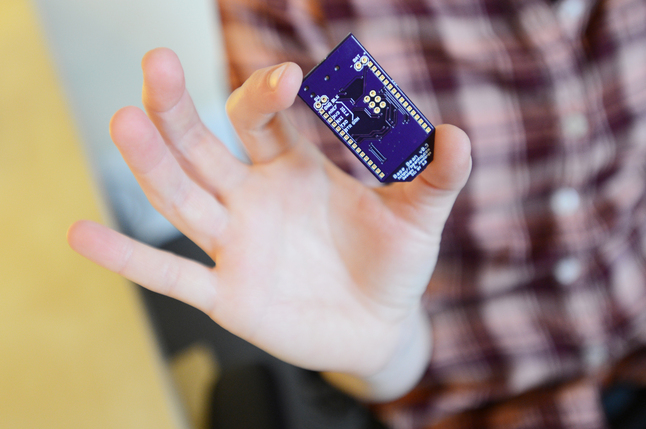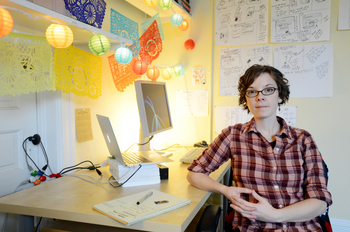
The Pinoccio is built onto a base board like this one held by co-founder Sally Carson. The device takes the soldering and etching necessities out of play so that programmers can focus on writing code and developing new capabilities for the chip.
Melanie Maxwell | AnnArbor.com
“In the same way that the web has democratized sharing data, sharing info, it’s now starting to bleed into real world projects,” co-founder Sally Carson said.
“That’s the ‘Internet of things,’ and that’s really interesting and really exciting for me.”
Get Ann Arbor news in your inbox
Keep your finger on the pulse of the Ann Arbor business community by signing up for the Business Review newsletter sent out early every Thursday morning. You can also sign up for the daily 3@3 email to see our best local stories every day.
The Pinoccio device is an improvement on the Arduino, a revolutionary hardware chip that allowed coders to write programs for electronic devices on a pre-formatted chip.
Programming hardware, devices that run electric components, used to require intense technical knowledge and a soldering iron. When the Arduino was released in 2005, it opened up some doors, but still left other barriers to would-be programmers.
“One of the first projects I tried was building a motion-activated jack-o-lantern for Halloween to scare kids when they came by my porch,” Carson said.
“So I had a motion sensor and a buzzer plugged into my Arduino chip and when it sensed a change in infrared light, then the sensor would tell the chip ‘something changed’ and the code in the chip says when that happens ‘buzzer make noise.’ It was a great little toy, but the problem was it had to be plugged into my computer for power.”
The problem of being tethered to the computer as a power source is solved with Pinoccio’s built in lithium ion battery that Carson says can last for weeks or months if the chip primarily is in its passive “sleep” mode.
Each Pinoccio device also is equipped with a wireless radio that can talk to other Pinoccios, and Wi-Fi “shields” that allow them to connect to the Internet are available. That connection allows the chips to both upload real-time data to the Internet as well as be programmed remotely to accomplish tasks.
“A lot of the people interested in this right now want to use this platform to do their own home automation projects,” Carson said.
“For example, I always ride my bike to work and sometimes when I’m halfway into town I can’t remember whether I left my garage open or not, so I’ll ride all the way back to check. If I had a Pinoccio hooked up with a sensor to know if the door is open or not I could go to a web page and see what the sensor reading was.”
Conversely, if Carson had a Wi-Fi enabled Pinoccio with her, it could sense when she enters or leaves the Wi-Fi range of her house and tell a second Pinoccio attached to the garage door opener to open or close the door for her.
Carson and Jennings started an indiegogo campaign to fund the first mass produced batch of Pinoccio chips and already have raised nearly $30,000 of their $60,000 goal with about a month to go. The company has picked up interest from Wired and Make magazines as well as the blog on adafruit.com, an industry leader in supplying hardware gizmos and gadgets.

Sally Carson's background is in user experience. From her office on State Street she directs the company's efforts to make the Pinoccio user friendly.
Melanie Maxwell | AnnArbor.com
“If they had a bunch of Pinoccios with little microphones attached, they could program them to recognize different frequencies and record it,” she said.
“The data could then be wirelessly uploaded and used to get a better idea of the movement patterns of different species.”
The device currently is being targeted to early adaptors and those with extensive programming experience who are able to take advantage of the chip’s capabilities.
Carson said she hopes the open source nature of the community will lead to sharing of these codes that will make it possible (eventually) for novices to attempt their own programming projects.
“ I will also be working on writing a bunch of tutorials that will go on the site to help people who would have no idea what to do after unpacking the box,” she said.
“That’s really important to me because I’m more like that, I’m still new to this world. I’ve been interested in it for seven years but I haven’t found that there’s an easy entry point to start working with the stuff. I want to make it accessible for beginners or teachers to use in a classroom teaching basic programming.”
While they currently have lined up manufacturing partners across North America for various pieces of the chip, Carson and Jennings hope to raise enough capital through their indiegogo campaign to begin producing the chips on their own.
“The revenue model is to sell it for more than it costs to make, which is nice,” Carson said.
“Coming from the web industry you’re often working on products where you say, ‘how are we going to make money off of this?’ This is old school commerce. It’s refreshing.”
Check out Pinoccio’s indiegogo campaign video:
Ben Freed covers business for AnnArbor.com. You can sign up here to receive Business Review updates every week. Reach out to Ben at 734-623-2528 or email him at benfreed@annarbor.com. Follow him on twitter @BFreedinA2